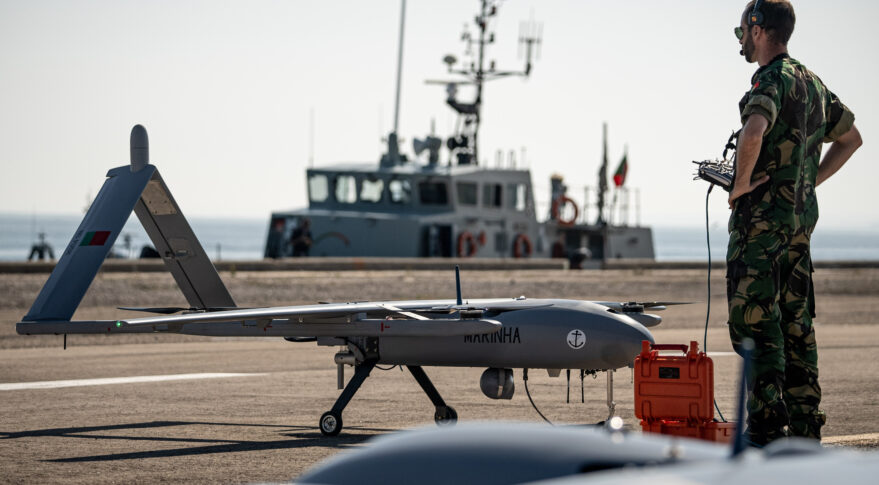
WASHINGTON — As SpaceX’s Starlink continues to gain military customers, the Pentagon worries that the company’s use of proprietary technology will make it difficult to integrate into a hybrid architecture that DoD hopes to build.
This is becoming an issue for the Defense Innovation Unit, which is leading a project to develop a hybrid space architecture, integrating satellite communications systems across low, medium and geostationary orbits.
Speaking Oct. 13 at the MilSat Symposium in Mountain View, California, Rogan Shimmin, program manager of DIU’s space portfolio, said it will be difficult to build a hybrid architecture if the largest commercial satellite internet constellation is not interoperable with other providers.
Without mentioning Starlink by name, Shimmin said “there is a particular commercial satellite provider in low Earth orbit, for example, that is several years ahead of the rest of the field. They do tend to try to establish interfaces, proprietary interfaces, that don’t necessarily want to play well with others.”
DIU’s hybrid space architecture would use commercial communication systems as transport pipes to move data collected by imaging satellites and deliver it quickly to government users. The concept assumes that commercial satellites will talk to each other via interoperable links.
Shimmin said his office awards contracts to commercial companies with incentives that “gently encourage different vendors to cooperate together.” By doing that, “we’ve created a much more collaborative relationship with our vendors.”
DIU is working with the Space Force and the Air Force Research Laboratory on the hybrid architecture. The project is intended to support Pentagon efforts to connect ground, air, maritime and space systems, a concept known as Joint All-Domain Command and Control, or JADC2.
The backbone of the hybrid network will be DoD’s Transport Layer, a constellation to be deployed by the Space Development Agency, he said. “We want to augment it with the commercial communications architectures that are coming online to proliferate the internet in space, get every satellite talking to every other satellite, relaying through ground stations regardless of who owns the ground stations, they should all function as routers.”
The thinking in JADC2 is “to embrace multiple providers so we don’t have a single point of failure,” said Shimmin.
In some ways, this is a “futuristic techno-utopia with satellites talking to each other,” he said. The problem for DoD is that the industry is moving forward “establishing their own partnerships, without government funding, and the government is trying to catch up.”
Military using Starlink
Meanwhile, the demand for Starlink’s internet services continues to rise across the U.S. military. The ever-growing constellation has now more than 3,400 satellites in orbit and has approval to launch up to 12,000.
The Air Force in recent contract documents said Starlink is the only provider that can meet the needs of deployed units in Europe and Africa. The U.S. Air Force 48th Fighter Wing based in the United Kingdom last month issued a sole-source solicitation for Starlink internet service at Royal Air Force Lakenheath, a host base for the F-35 Joint Strike Fighter aircraft.
Starlink also is being used in multinational military exercises that require connectivity between ships, aircraft and operators on the ground.
Vice Adm. Brad Cooper, commander of U.S. Naval Forces Central Command in the Middle East, said Starlink internet is an example of commercial technology that is filling critical military needs.
During a roundtable with reporters at the Pentagon Oct. 12, Cooper said Starlink was used to connect drones operated by U.S. and allies forces in a recent NATO exercise off the coast of Portugal.
During the exercise, approximately 120 unmanned aircraft, vessels and underwater vehicles were integrated into a common network.
Cooper said U.S. Naval Forces Central Command, based in Bahrain, conducts dozens of maritime security exercises with allies. A goal for next year is to deploy as many as 100 U.S. and allied unmanned surface vessels in the Persian Gulf and the Red Sea for maritime surveillance.
As more data is collected by drones, there is a greater demand for connectivity so information can be uploaded and analyzed in a timely manner, Cooper said, adding that U.S. and allied forces in the region plan to use Starlink next year when it’s expected to be available in the Middle East.
During the NATO exercise in Europe, “what we found is that it works perfectly great,” Cooper said. The data moves at speeds much faster than with previous systems, and at less cost, he added. “So that’s the future.”